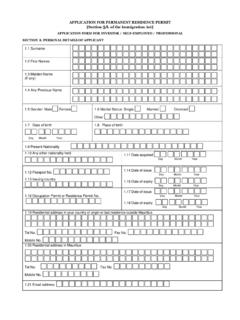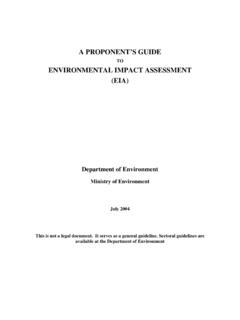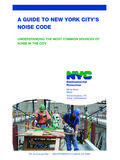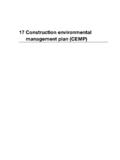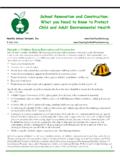Transcription of A PROPONENT’S GUIDE TO PRELIMINARY …
1 REVISED VERSION A PROPONENT S GUIDE TO PRELIMINARY environmental REPORT (PER) Department of Environment Ministry of Environment and National Development Unit October 2009 This is not a legal document. It serves as a general guideline. Sectoral guidelines are available at the Department of Environment TABLE OF CONTENTS Introduction 3 Objective 3 Guideline on the Contents of a PER 4 Title Page 4 Table of Contents 5 An Executive or Non Technical Summary 5 Introduction 5 Site and Project Description 5 Site Description 5 Project Description 6 Method of Assessment Including Baseline Data 7 Assessment and Mitigation of Direct and Indirect environmental
2 Impacts 7 Socio Economic and Socio Cultural Impacts 8 Residual Impacts 9 Cumulative and Synergistic Effects 9 Checklist for Monitoring Purposes 9 Enhancement Opportunities such as Landscaping and Embellishment 9 Identification of any Additional Studies 10 Consultation 10 Any Alternative 10 Conclusions and Summary of environmental Outcomes 10 317 Supporting Documentation & References 10 Appendices 10 Appendices 11 Appendix 1: List of undertaking requiring a PER 12 Appendix 2: Requirements for a PER according to EPA 2002 as amended in 2008 13 2 INTRODUCTION A PRELIMINARY environmental Report (PER) is a short form of an environmental Impact Assessment (EIA), and is generally meant for assessing projects with lesser environmental impacts.
3 This PRELIMINARY analysis is undertaken to identify the impacts associated with the proposed development and the means of mitigation. PER is an important tool for sound decision making and for achieving sustainable development. The PER mechanism was introduced in the Environment Protection Act (EPA) 2002. With the coming into force of the Business Facilitation (Miscellaneous Provisions) Act 2006, undertakings which are less polluting have been waived from the lengthy administrative procedures for processing of applications. In the same context, Part A of the First Schedule of the Environment Protection Act (EPA) 2002 which pertains to the list of undertakings requiring a PER has been reviewed to exclude certain undertakings from it. Consequently, the First Schedule to the EPA 2002 has been repealed and replaced by the Environment Protection (Amendment of Schedule) Regulations 2006.
4 The list of undertakings warranting the approval of a PER is at Appendix 1. EPA 2002 also empowers the Minister to request a PER for any non-listed activity, which, by reason of its nature, scope, scale and sensitive location could have an impact on the environment. The processing of a PER application involves consultation with several Ministries/Authorities. Thus, a proponent applying for a PER approval shall submit 10 copies of the PER and such additional copies as the Director may request. Requirements for a PER as per EPA 2002 as amended in 2008 are at Appendix 2. OBJECTIVE The objective of this guideline is to assist proponents and consultants in the preparation of a comprehensive PER on a project to enable a timely processing of the application. This guideline provides general guidance for the preparation of a PER. This guideline should be complemented by sectoral guidelines (available on this ministry s website) and other relevant guidelines such as the Planning Policy Guidance, National Development Strategy, Outline Schemes and relevant Acts and Regulations.
5 GUIDELINE ON THE CONTENTS OF A PER The proponent or the consultant preparing a PER should ensure that all the environmental and socio-economic parameters are addressed and their impacts are identified and taken into account in the project design. The PER should not comprise statements of a general nature but instead should provide substantive and indicative information on the proposed measures to mitigate all adverse environmental impacts as well as on the opportunities for environmental enhancement so as to enable a proper assessment. Prior to embarking on a project, a proponent should ensure that the proposed development is compatible with the zoning of the site and that relevant clearances such as zoning certificate, land conversion permit or lease agreement (if applicable) have been obtained. In case of inappropriate zoning and the absence of proof of land ownership or authorisation, the PER application will not be considered.
6 A PER should be in conformity with such policy or environmental guidance as may be published in respect of an undertaking and should be duly signed and dated by either the proponent of the undertaking or his legal representative and countersigned by the consultant. The preparation of a PER includes the following studies: Collection of baseline data and information; Identification of impacts in terms of magnitude and significance; Mitigating measures for each impact identified; Analysis of alternatives of the project; Development of a monitoring programme and environment management plan The above studies should be documented in the form of a PER. The format below provides a GUIDE for the preparation of a PER:- Title page This should contain details of: The full title under which the PER has been prepared; Location of project; Name of the project initiator/proponent, signature and contact details (address, phone and fax numbers); 4 The team responsible for the preparation of the PER or name(s) of the consultant(s)/ consultancy firm and contact details (address, phone and fax numbers) Table of Contents The table of contents should indicate the different chapters with their respective page numbers.
7 An Executive or non technical summary The summary should be concise and give a short overview of the proposal. The language used should be simple and non technical. It should focus primarily on key impacts identified in the PER and measures taken to avoid and /or reduce them. Introduction It should provide background information on the project, the promoters, objective and justification of project, any experience in similar projects, project costs, benefits, employment opportunities, as well as the technical, economic and environmental features essential to the project. Site and Project Description This section should describe the site and the project and should indicate the justification and rationale underlying the project. Site Description The site description should include:- Project location and land extent. The project location shall be indicated on a map drawn to a scale of 1:25,000; Ownership of land and proof thereof, or lease agreement clearly indicating the owner s consent to the project; Present zoning of the site as per approved and recent Outline Scheme (can be obtained from the Town & Country Planning Board or the Local Authorities); Plans and policies with which the project conforms; Site characteristics in terms of site location, landform, magnitude of slope of site (supplemented by interval contour map), geology, soil type, topography, water table level, prevailing wind direction, type of flora and fauna, presence of any rare or 5endangered species, sensitive habitats of ecological importance, present and past land use (if known), accessibility to site, etc.
8 Certified and comprehensive site/location plan drawn to scale and duly certified by a Sworn Land Surveyor with known landmarks as reference points and showing any environmentally sensitive areas, water bodies, wetlands, boreholes and any existing development in the vicinity (within a 500m radius); Description of the surrounding environment indicating adjacent land uses, residential areas/built-up environment, environmentally sensitive areas, watercourses(canals, rivers, streams, natural drain), designated sites of interest, and other attributes of the area amenities, recreational and agricultural values; Indication of other similar projects in the surroundings; Existing infrastructure and availability of statutory services (water, electricity, sewerage system and telephone lines); The future development projects under the outline scheme should also be located in the site plan of the proposed development, as far as practicable; The site topography with contour lines at m intervals should be submitted by the proponent; The proponent should send comprehensive and certified site plans for an easy location; Project Description The project description should include: Type of project and associated activities to be carried out; The design, size and scale of the project; Detailed site/layout plan drawn to scale of 1:500 (as applicable) indicating site boundaries (as per title deeds), all existing development on site (if any) and all proposed structures to be put up on site with setbacks from site boundaries.
9 The layout plan of scale (1:500 or better) shall indicate the relevant set back of 30m from all natural water courses (canals, rivers, streams) and show compliance of the proposed development as per Rivers and Canals Act. Detailed plans indicating elevations, plot coverage and gross floor area. 6 Description of project in terms of raw materials, products, process technologies, equipment, machinery (Horse Power and noise level), work force, type of fuel used, hours of operation, marketing of products, etc; Layout plans of the proposed or existing building, architectural plans, photographs and aerial photographs whenever necessary (aerial photographs are available at the Ministry of Housing and Lands); Plans submitted should meet the design criteria-spelt out in the Planning Policy Guidance. Architectural drawing of building and site plan; Safety data sheets for chemicals; Information as per Fire Prevention Form II Flow chart of the process production and explanation on the process; Project life cycle; Proposed schedule for implementation; Zero development option; Method of Assessment Including Baseline Data Baseline information on which the PER was based upon; Data source, data collection methodology ( survey, matrix or checklist) and results of site investigation; Any constraints in collection of data or omissions in data collected and proposed remedial measures; A geotechnical report including description of subsurface strata up to 3m deep, maximum level of water table and results of percolation test as per BS 6297 as applicable.
10 The geotechnical report shall be certified by a Civil Engineer registered with the Council of Registered Professional Engineers (Mauritius) or a Soil Scientist. (Note: The onus of requesting a geotechnical report/percolation test rests with the Wastewater Management Authority who might request same on a case-to-case basis depending on the sensitivity of the site. Proponents/Consultants are advised to consult the Wastewater Management Authority in order to ascertain as to whether a geotechnical report is required for a particular project); Baseline data on prevailing climatic conditions (as applicable), namely rainfall, temperature, relative humidity, wind direction and speed, ambient air quality, water 7 Assessment and Mitigation of Direct and Indirect environmental Impacts This section should describe all the direct and indirect environmental impacts during the construction, operation and decommissioning (if any) phases of the project.


